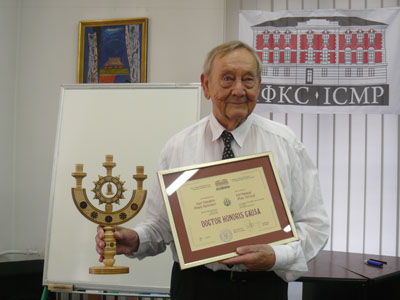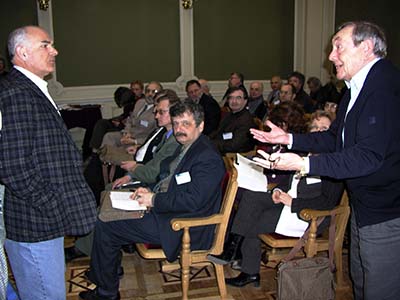About Institute / Doctors honoris causa / Karl Heinzinger
Karl Heinzinger
 According to the decision of the Scientific Council of the Institute for Condensed Matter Physics of National Academy of Sciences of Ukraine from May 14, 2015 the title of Doctor Honoris Causa is conferred on Karl Heinzinger (Mainz, Germany) for pioneering studies of electrolyte solutions by means of molecular dynamics computer simulations and for important role in establishing computer modelling as one of the main fields of research activity of the Institute.
According to the decision of the Scientific Council of the Institute for Condensed Matter Physics of National Academy of Sciences of Ukraine from May 14, 2015 the title of Doctor Honoris Causa is conferred on Karl Heinzinger (Mainz, Germany) for pioneering studies of electrolyte solutions by means of molecular dynamics computer simulations and for important role in establishing computer modelling as one of the main fields of research activity of the Institute.
Karl Heinzinger was born on December 25, 1930 in Klein-Auheim, Landkreis Offenbach, Hessen. In 1951 he started to study physics at the University of Frankfurt and in 1957 received diploma from the Institute of Applied Physics. The research career of Karl Heinzinger began when he was working at the Max-Planck Institute for Chemistry in Mainz. In 1961 he has received PhD from the University of Mainz and after that spent two years from 1962 as a Postdoctoral Research Associate at the Chemistry Department of the Brookhaven National Laboratory, Upton, N.Y., USA. In 1964 Karl Heinzinger came back to Germany and was appointed to head the Physical Chemistry group at the the Max-Planck Institute for Chemistry (Otto-Hahn-lnstitut) in Mainz. In 1996 Karl Heinzinger has retired.
The first scientific projects of Karl Heinzinger were concerned of the heat capacity of ortho and para hydrogen at low temperatures. In general, the subject of isotope effects in water and aqueous solutions have prevailed during the earlier stage of his scientific career.
Starting 1973 Karl Heinzinger and his group turned attention to classical computer modeling of water and aqueous electrolytes. This activity was directed towards investigation of the properties that remained unknown or at least were less known for researchers at that time. The central topic among others required investigation of the structure of ion hydration shell and its impact on the dynamic properties of the electrolytes.
Aiming to study the ion effect on the properties of water, Karl Heinzinger in collaboration with Philip Bopp and Gabor Jancho in 1983 have suggested a non-rigid water model (Bopp-Jancho-Heinzinger or BJH model of water) which became rather popular among the physical-chemistry community interested in water and electrolytes as well as more generally in computer modeling of aqueous media in various fields of scientific knowledge (as for today there are almost 500 citations according to ISI Web of Knowledge). Studies based on this model have revealed significant changes in the internal structure of water molecules that belong to hydration shell of the cations Ca2+ and Mg2+ as the result of the interaction with the cations. Later on these results have been used here at ICMP of the NAS Ukraine to model the cation hydrolysis caused by high valency cations.
Some other important objects were investigated in Heinzinger group and include water-alcohol solutions, in particular, the aqueous solution of methyl alcohol, metal-ammonia solutions, mercury-electrolyte and platinum-electrolyte interfaces and some other systems. An important feature of all studies carried out under Heinzinger’s supervision is a combination of computer simulation techniques with quantum-mechanical calculations of the ion-water interaction potentials, making use of as much as possible realistic potential models, carrying out computer experiments at fixed ionic concentration as well as tight collaboration with various experimental groups. Besides the basic science, Karl Heinzinger was interested in various practical aspects, including geological, related to the study of aqueous electrolytes at high pressures and temperatures.
During many years Karl Heinzinger was maintaining close scientific contacts with scientists from ICMP of the NAS Ukraine. The first visit of Karl Heinzinger to Lviv occured back to 1983 when he was invited to attend the International School on ionic solvation. Back to Germany, Karl Heinzinger started looking how to formalize the collaboration of his group with Lviv group on statistical physics. In 1985 based on his proposal it has been signed the first three-years agreement on scientific collaboration between Lviv Department of Statistical physics of the Institute for theoretical physics of the Academy of Sciences of Ukraine (from 1990 – the Institute for condensed matter physics of the National Academy of Sciences of Ukraine) and the Max-Planck Institute for Chemistry (Otto-Hahn-lnstitut). This agreement has been extended twice up to 1994. With this agreement many researchers from Lviv visited Mainz and vice versa. As the result, several research papers have been published. Besides the research activities, Karl Heinzinger was an active participant of the joint projects aimed to bring the international meetings to Lviv. The most recent of which is concerned the 2004 NATO Advanced Research Workshop on ionic soft matter: Modern trends in theory and applications.
 Karl Henzinger discussing with Ivo Nezbeda from Chech Academy of Sciences during the NATO Advanced Research Workshop on Ionic Soft Matter.
Karl Henzinger discussing with Ivo Nezbeda from Chech Academy of Sciences during the NATO Advanced Research Workshop on Ionic Soft Matter.
April 14-17, 2004, Lviv, Ukraine